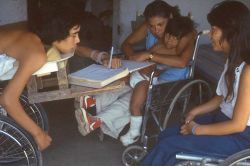Hesperian Health Guides
Evaluation
HealthWiki > Disabled Village Children > Chapter 50: Organization, Management, and Financing of a Village Rehabilitation Program > Evaluation
An ongoing process of evaluation by the members of a community program is necessary if problems are to be corrected and improvements made.
| Evaluation is a tool for problem-solving and planning. |
Informal evaluation can take place often: the group sits down together once a week (or even for a few minutes once a day) to discuss successes and failures, what seems to be working well, and what does not. Together the group looks for solutions and makes plans.

A somewhat more formal evaluation might be done at the end of each month and each year.
The PROJIMO team, at the end of each month, makes an effort to fill out an evaluation form that outlines the following information:
- numbers and names of workers involved, the responsibilities of each, hours worked, and pay received
- number of children seen (new and returning) at the center and in their homes. Also their ages, type of primary disability, and secondary disabilities.
- number of children who stayed at PROJIMO for more than one day, for how long, and with what family members
- attention received by children and families: hours of instruction or therapy, number of braces, limbs, wheelchairs, and other aids or equipment made or provided
- accounting for costs of the above, including what portion was paid by each family and how much was paid by the auxiliary fund
- summary of financial accounts with lists of all monies gained and spent
- summary of evaluations of individual children by the PROJIMO team and by their parents (This includes a list of children who have made return visits, with comments on their progress and response to suggestions, home therapy, or aids.)
- volunteer help or participation by members of the community (children and adults)
- number and profession of special visitors or visiting instructors
- new relations or interactions with other rehabilitation centers, programs, and communities
- feedback based on parent questionnaires, what they and their children have gained from PROJIMO, how they feel they were treated, what criticisms they have, and suggestions for improvement
- outstanding problems and successes in each of the main activities of PROJIMO
- conclusions and recommendations
To help in the evaluation of PROJIMO, parent questionnaires are given to each family at the end of their first visit. Another questionnaire is sent several months later, to learn more about how the child has (or has not) benefited.
The PROJIMO workers are still not happy with the forms and questionnaires they are using, and have revised them several times. For this reason, we do not include samples here. However, we would be glad to send our forms, such as they are, to anyone who thinks they might help in designing their own.
In addition to the monthly written evaluation, at the end of each year the PROJIMO team has an “evaluation dinner.” The team invites some children with disabilities, their parents, and some members of the community to participate. The activities of the past year are reviewed, along with problems and successes. The long-range vision and direction of PROJIMO is discussed. Based on this discussion, plans, changes, new activities, and goals are outlined for the coming year.
When families first arrive at PROJIMO, they are given a leaflet which describes the program. It describes or lists:
- the reason for the program
- who the workers are
- how the family can help (work that can be done)
- suggestions for donations such as blankets, wood, rope, food
- the services provided
- the disabilities that are attended
This is the way the leaflet starts:




